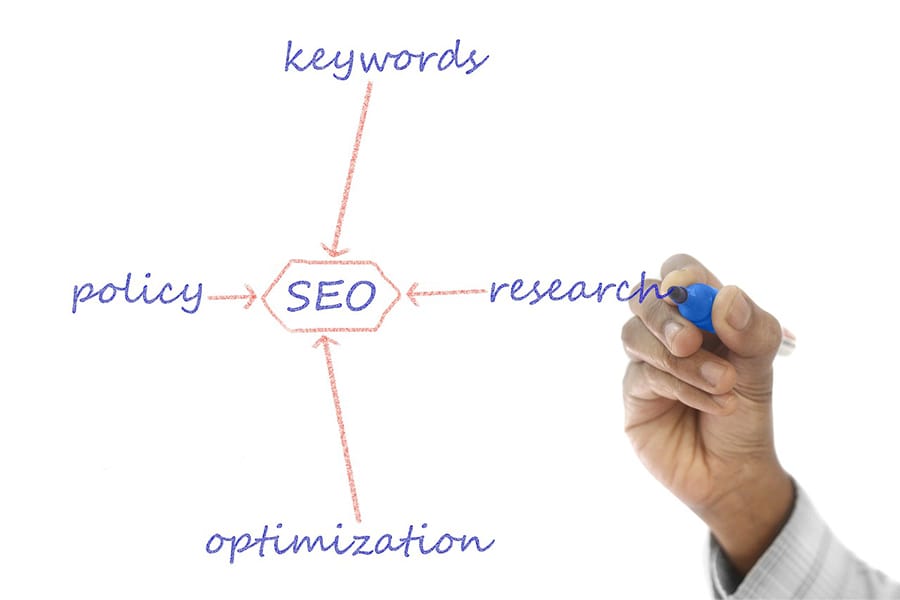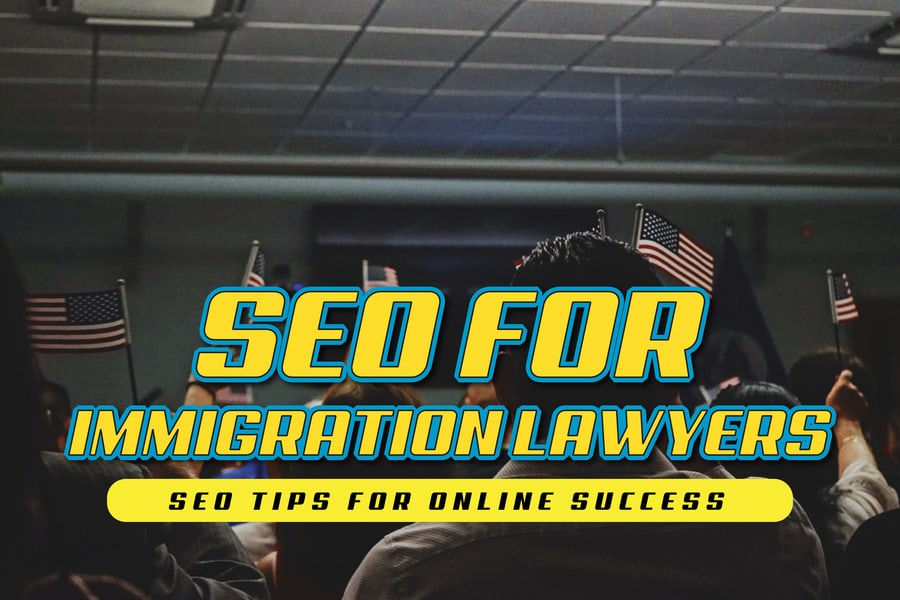If you want to implement effective SEO for immigration lawyers, get an agency like LawFirmSEOExpert ready to go the extra mile to deliver results, not excuses.
The digital space (internet) is a highly competitive place. Tons of immigration attorneys are out there desperately looking for clients. So, you’ll need an effective SEO strategy for your law firm to rank high on search engine results pages to get clients.
SEO can help immigration attorneys succeed in their practice area and geographical location. However, you must have an effective plan that yields results.
In this post, we’ll discuss the benefits of immigration law firm’s SEO and the strategies to secure more clients and generate higher revenue. Let’s get down to business!
What Is SEO For Immigration Lawyers?
SEO means search engine optimization. It involves online and offline activities you perform that directly impacts your website visibility, organic web traffic, and online reputation.
So, if you are an immigration lawyer, start taking SEO for your immigration law firm’s website seriously. Why? There are lawyers offering immigration legal services in your location working hard to attract more legal consumers seeking immigration lawyers. Don’t give them a chance to rank above you in search engine result pages for your target keywords. If they do, they could get clients that would have been yours.
You can’t afford to lose clients to your competitors. It should be the other way around. Build a solid SEO foundation for your law firm’s website, and you’ll consistently rank high in search engine results pages for your target keyword.
LawFirmSEOExpert understands how vital a single client can be for a law firm. Attorneys can generate thousands of dollars from a single client. That’s how the business works.
LawFirmSEOExpert wants your law firm to flourish. Thus, I’ll go the extra mile and implement diverse SEO strategies to get your immigration law firm to the top of SERPs where potential clients can find you.
What Are The Types of Immigration Law Firms SEO?

SEO (search engine optimization) is the same. There is no special SEO for immigration law firms. Search engine optimization is a broad term. It refers to the steps one takes offline and online to help a website rank high in SERPs, generate more organic web traffic, create brand awareness, and build a robust online reputation.
So, here, we’ll discuss the various types of SEO (search engine optimization). After reading this section, you’ll have a sound understanding of the various aspects of SEO.
Let’s dive in!
#1: On-Page SEO For Immigration Legal Services
What’s on-page SEO? It also means on-site SEO. It means optimizing a site’s elements, such as content (blog post) and HTML code. The aim is to improve the website’s search ranking and increase organic traffic.
On-page SEO is entirely different from off-page SEO. While on-page involves everything you do on the website to improve ranking, off-page focuses on everything you do outside the website to improve ranking, web traffic and reputation. So, both strategies have or achieve the same goal.
Off-page optimization includes optimizing external factors affecting your site’s ranking, organic traffic and online reputation. These include backlinks and social signals.
Now, let’s discuss the different strategies or steps in on-page SEO. Here’s a summary before we go into the various strategies properly.
- Keyword research
- Content creation
- Internal linking
- Metadata SEO
- Image optimization
- URL Structure
So, these are the on-page SEO strategies we’ll be discussing shortly.
Keyword Research for immigration law practice:

Keyword research involves identifying key phrases or search terms people use when searching for information, products or services online.
For an immigration lawyer, key phrases include search terms legal consumers seeking qualified immigration attorneys use when searching online.
Google operates based on keywords. So, choosing the right keyword is important in any SEO project. Your target audience will struggle to find you once you use the wrong keywords.
There are several keyword research tools you can use to find relevant keywords. But while some keyword research tools are free, some aren’t. The paid tools offer in-depth details on each keyword, helping you to make an informed decision.
For instance, you’ll have keyword search volume, difficulty, intent, and trend information.
Check out the keyword research tool examples to find the right keywords.
- AlsoAsked
- Soolve
- QuestionDB
- Google Trends
- Keyword Surfer
- Keyword Gap
- Keyword Manager
- Organic Research
- Keyword Magic Tool
- Keyword Overview
- AnswerThePublic
- Organic Traffic Insights
- Google Keyword Planner
Keywords are important, and there are various types of keywords. The two popular ones are short-tail and long-tail keywords.
The short-tail keywords are phrases with one or two words. They are generic and have high competition. Examples include Immigration lawyers, immigration attorneys, etc. You can see how short these keywords are.
Short-tail keywords have high search volume and high competition. And ranking websites for such keywords is a tough one. You’ll spend way more money and time to improve ranking when targeting such keywords.
Instead, target long-tail keywords. They may have lower search volume than short-tail keywords, but offer your website a better opportunity to rank in SERPs. Click-throughs for long-tail keywords can be higher because legal consumers using such keywords may most likely be serious about hiring an immigration legal practitioner.
Examples of long-tail keywords include:
- Immigration attorneys in [city]
- [city] immigration law firms
- Immigration lawyers in Miami
- Immigration attorneys in Houston
- Dallas immigration lawyers
- Best immigration law firms in New York, etc.
Another important thing we need to discuss is where to place the keywords to optimize your content. Incorporate your target keywords in your headers, the content body, and the Meta tag.
A Handy Tip On Keyword Usage:
- Use long-tail keywords
- Place keywords in your headers, body of the content and Meta tags.
- Avoid keyword stuffing. It will hurt your website’s search ranking, credibility and confuse visitors.
- Target the right keywords. If you’re an immigration lawyer operating in Houston, you can target legal consumers seeking immigration lawyers in Houston.
- Avoid using similar keywords throughout your website. Use different keywords to boost your chance of ranking for different key phrases.
Note: The danger in using the same keyword throughout your website is that you’ll compete against yourself.
Furthermore, when Google finds two web pages on a site targeting the same keyword, it will rank the low-quality content and leave the main one behind.
Content Creation for immigration lawyers:

The next and highly important on-page optimization strategy is content creation. Without content, you cannot optimize your website. Additionally, visitors won’t have anything when they land on your website.
High-quality content informs, educates and solves visitors’ problems. It addresses the reason a visitor landed on your website in the first place. High-quality content is well-optimized, improves website ranking, online credibility, and helps you secure more quality backlinks.
People will want to link to your content without you soliciting for it. And that is a big boost to your SEO effort.
High-quality content is search engine-friendly and user-friendly. It meets users’ needs and is properly optimized to make understanding the content hassle-free for Google search engine. Use the right keywords and strategically place them in your content.
Here are effective content-writing tips:
- Find the right keywords: The first step is to know the keywords you want to target. You’re an immigration lawyer (law firm), so all the content you’ll produce and publish on your immigration law website should be centered on immigration laws in the United States, Canada, Australia, or any part of the world where you’re practicing.
- Research the topic using the keywords: When you search online using your primary keyword, you might find topics other law firms have written about. Read their content. Why? The essence is to see what they have done and produce a more in-depth, superior blog post that solves users’ problems completely.
A Handy Tip: Don’t copy from your competitors’ websites. Make your content 100% unique, information-packed and well-optimized. A website that copies content from others can’t rank higher than the site it copied from.
Again, Google has a way of detecting plagiarism, and it may go hard on your website if the original owner files a complaint that you copied. In most cases, people who plagiarize sent
How can you identify plagiarism in your content? You can use a tool like “Copyscape” to identify plagiarism in a blog post or article.
- Start your content with a killer headline: What’s the first thing visitors see before reading the rest of your content? Your headline! If your headline is attention-grabbing and catchy, more visitors may click on your link to consume the entire content. So, write a powerful headline. Make visitors more interested in consuming your entire content.
- Write for your target audience: Keep your target audience in mind when writing your content. Ask yourself questions like, “what do my visitors need to know?” What are their interests? Sometimes, you need to put yourself in their shoes to understand the content they want to consume.
- Use catchy visuals: Use powerful visual materials like videos, images, or infographics. Ensure your visual materials are always high-quality and irresistible. Visual materials help break up texts and make content more appealing to readers.
- Proofread and edit your content ruthlessly: Before hitting the “publish” button, take a moment to proofread and edit your content. Check for spelling mistakes, grammar errors, faulty tenses, overused words, passive voice, etc.
Internal Linking:

Internal linking is another website optimization strategy. It involves placing links (from the same website) within an article to connect relevant pages.
Here is an example of an internal link. This post discusses how to use SEO for a law firm. You can read it up if you want to understand the various SEO strategies faster.
You can see the link I incorporated in the keyword “how to use SEO for a law firm.” I also added a link to that article for easy access to the page.
Internal linking helps to improve user experience and enables search engines to understand the hierarchy and content of a website.
Internal linking is a crucial SEO strategy for any immigration law firm website seeking higher rankings in Google. It helps Google find, index, and understand all the pages on a website.
A Handy Tip: It is important to use internal linking properly. Why? If you do, it will send page authority (PageRank) to some of your vital pages.
Here are the best practices for internal linking for search engine optimization.
- Utilize keyword-rich anchor text
- Link to valuable pages
- Avoid using the same anchor text for two different web pages
- Audit your internal links using the Google search console
- Place internal links high up on your web pages
- Link strategically from your site’s homepage
- Incorporate internal links in aged pages
- Use do-follow links to send PageRank around your web pages.
Metadata SEO:
What’s Metadata optimization? It involves optimizing the HTML elements such as header tags, title tags, and Meta descriptions to briefly and accurately convey what the web page is about to users and search engines. The aim is to boost the online visibility and relevance of the web page in search engine result pages.
Here are important Meta tags and metadata for search engine optimization:
- Title tag
- Meta description
- Hreflang
- Canonical tag
- Header tags
- Alt text
- XML Sitemap
- Robots.txt
- Structured data
Here are tips on how to incorporate Meta tags and metadata into a website:
- Know the important pages on your site you want to optimize for search engines.
- Determine the search terms (keywords) you want to target on each web page.
- List the meta tags and metadata you want to incorporate into each page.
- Incorporate the meta tags and metadata into each web page’s HTML code.
- Test the meta tags and metadata to confirm if they are working perfectly.
A Handy Tip: Using a Google Webmaster tool, you can test and verify if your web page’s meta tags and metadata are working well.
Another way to know if the meta tags and metadata are still functioning is to search for the web page on search engines. Have a look at the title and description, including the keywords used.
Image Optimization:

What’s image optimization? Optimizing a website’s images using descriptive file names, captions, and alt tags improves search engine visibility and user experience. One of the primary goals of website image optimization is to increase organic traffic to a website via Google image search.
Image optimization can directly impact your perceived credibility, accessibility, professionalism, search engine optimization, and user experience. A complete immigration lawyer website image optimization is essential for any successful search engine optimization strategy.
Here are tips to optimize your immigration law firm website’s images to improve ranking, organic traffic, and credibility.
- Ensure the image format is right: You must strike a healthy balance between file size and quality. Thus, if the image boasts plenty of colors, use JPEG format. But if the image boasts simple graphics, use PNG.
- Fix image sizes: Desist from uploading any image you find attractive. Consider the image size before you think of uploading it. Optimizing image dimensions is a great move. Uploading large images on your law firm’s website can slow down and hurt your search engine optimization effort. It can also give your site a terrible user experience, affecting its ranking and traffic. So, reshape your images before uploading them on your website.
There are diverse image editing tools and plugins you can utilize. And some of the editing tools and plugins will neatly reshape your images without compromising their quality.
- Compress images before uploading: Uploading images with large file sizes will slow your website speed. And that’s a huge setback in your SEO effort. So, compress your images using the best photo compression tools. You can use such tools to lower your image file size significantly without compromising your images’ visual appeal and quality. For creative image presentation ideas, you can also try a photo collage maker to combine and showcase images beautifully.
The bottom line is to improve your website’s load speed by uploading compressed yet high-quality images.
- Incorporate description and alt text into your images: The benefits of descriptions and alt text are enormous. They help make your website accessible to visually impaired people, give search engines valuable information and boost user experience for people using slow internet connections.
- Use lazy loading: This technique is useful for deferring non-visible photo loading until visitors scroll further down the web page. What does this mean? It implies that only images relevant to the section the user is reading will be displayed.
Each image will only be displayed when the user scrolls to the section of the web page where the image lies. Lazy loading is an ideal strategy to ensure image-heavy pages don’t experience horrible loading speed. In general, it improves website loading speed.
- Leverage responsive images: Use the srcset attribute in your web page’s HTML to ensure the right image is served to the user’s device. This attribute will ensure visitors get the ideal images based on their devices.
- Save image files with descriptive names: Avoid generic names. Using descriptive file names will help search engines understand the content of your images.
Here are the reasons image optimization is a vital SEO strategy for immigration lawyers:
- Eliminates poor the possibility of a site load speed: We’re in the digital age where people have short attention spans. People appreciate websites that load within 1-2 seconds. Google even wants websites to load faster (under half a second).
Optimizing website images helps reduce the file size and dimension without compromising quality. A website that loads faster offers a great user experience.
A website that loads faster will encourage users to spend more time on the page and consume your quality blog posts. This will lead to a lower bounce rate, giving Google the impression that your content is high-quality and valuable.
A Handy Tip: website load speed is an integral Google ranking factor as it influences user experience.
- Boost your site’s search ranking: Optimize your images to improve your ranking on SERPs. Note that Google Image boasts its ranking algorithm for visuals. Images are crawled and indexed much faster.
A Handy Tip: You must also understand that an effective image optimization strategy can positively impact your image’s search engine ranking and traditional search ranking.
- Improves your credibility and professionalism: Uploading high-quality and well-optimized images on your site will portray you as a true professional. A visually appealing website creates a good first impression, captivates, makes brands memorable, and instills confidence in potential clients.
- Improve user experience: Image optimization enables websites to display images perfectly on any device or screen, giving users a seamless and memorable experience. Visitors will have a good perception of your immigration law firm.
URL Structure:
What does URL structure entail? It involves how a website’s URL is designed and organized, incorporating the right keywords to give search engines a proper understanding of the website content, boosting website ranking, improving the website’s user experience, and encouraging link-building efforts.
A Handy Tip: A URL is an address on the internet, and it’s made up of several components such as protocol, domain name and a path.
Image Showing URL Structure
[PLEASE, I WANT A SIMILAR IMAGE DRAWN HERE. ADD THE WRITEUP ABOVE AND USE A DIFFERENT URL TO REPLACE THE ONE ABOVE].
What’s a protocol? It refers to how the browser receives information about a page. It can do so either via http:// or https://. The letter “S” stands for secure.
URL structure is beneficial for SEO. Here’s how it can benefit your law firm business.
- Improve user experience: Using SEO-friendly URLs improves user experience. It will enable visitors to understand the content on a web page before even visiting. An SEO-friendly URL is simple, includes a key phrase that describes the content on a page and is easy to read.
Here is an example of an SEO-friendly URL:
You can see the keyword “how to do marketing for a law firm.” I incorporated it into the website’s URL.
Such simple URLs will make it easier for potential visitors to click your website link to consume the content.
- Important for PageRank: URL structure helps Google understand what each page of a website is about.
URLs are one of Google’s ranking factors. Thus, URL structure can directly impact a website’s PageRank (PR). It makes it a breeze for Google crawlers to crawl, index and display a website in relevant search results.
A Handy Tip: Root domains boost the most PageRank. Thus, incorporating relevant keywords in your root pages can boost your website ranking.
But then, don’t focus on URL keywords alone to rank. Google considers numerous factors to rank web pages, so SEO is complicated.
Furthermore, avoid stuffing your URLs with keywords. It will only hurt your SEO effort, deliver a terrible user experience, and confuse visitors. So, don’t stuff your URL with keywords.
Instead, use only relevant keywords in your URL. Make your URLs SEO-friendly, boosting the likelihood of your link being clicked.
Now, here are ten must-know SEO best practices for website URLs. When you implement this strategy, your website will rank high, and you’ll start getting organic traffic to your website.
- Use a good URL structure for all your web pages.
- Use the HTTPS protocol.
- Keep the www prefix hidden.
- Keep your web page URLs short and simple
- Edit web page URL to ensure it is SEO-friendly and relevant
- Use your primary keyword and avoid keyword stuffing.
- Separate words in the URL with hyphens.
- Utilize lowercase letters
- Get rid of stop words
- Redirect the old URLs
- Get rid of dates from your blog posts
2: Off-page SEO For Immigration Law Firm Website:

Off-page is another form of search engine optimization. It is different from on-page, but both processes have the same goal. The goal is to increase a website’s ranking, traffic and online reputation.
Off-page SEO is also called off-site SEO. It involves what you do outside a website that directly impacts it and encourages improvement in search ranking.
Examples of off-page search engine optimization include link-building, promoting your law firm website on social media, and other activities done outside the website you want to improve.
As explained before, off-page SEO aims to improve a website’s online reputation, authority, ranking, and traffic. So, it’s an important strategy to grow a website.
Here are the off-page SEO strategies immigration law firms can deploy to improve their website’s ranking, traffic, online reputation and authority.
- Guest posting
- HARO
- Brand signals
- Press release distribution
What does each off-page search engine optimization strategy mentioned entail? Check them out.
Guest blogging or guest posting:
This off-site optimization strategy involves writing an article, publishing it on a different website and incorporating a link from your website in the article.
Backlinks are usually of two types. There is do-follow and no-follow. The do-follow links pass link equity to your website. They also allow search engines to follow them.
The no-follow link is the direct opposite. It doesn’t allow search engines to follow it and won’t pass link equity to your website. However, visitors can reach your site via the no-follow link.
A Handy Tip: It is important to build a “healthy backlink profile.” Avoid links from spammy websites that don’t follow SEO best practices.
Additionally, get niche-relevant and high-quality backlinks. Always remember that Google pays attention to the relevance of your links.
Though do-follow backlinks will pass link equity to your website, avoid acquiring only do-follow backlinks. Why? You’ll give Google a bad impression about your website when you do so. In other words, the search engine giant will feel you’re trying to trick the system, and they hate that.
Have a healthy balance of do-follow and no-follow links. Don’t go after only do-follow links.
HARO outreach:
HARO Outreach is a great strategy law firms can use to create brand awareness, generate impressive referral traffic and improve website ranking. It involves responding to reporters and journalists for media exposure and valuable backlinks to improve your website’s SEO.
Brand signals:
What are brand signals? It implies a brand’s online presence and reputation established via online directory listings, social media engagements, and mentions on other websites.
Brand signals are important for SEO. They can help search engines determine a brand’s credibility and authority. In a nutshell, brand signals can directly impact search engine rankings.
Press release distribution:
Press release distribution is an important and effective off-page optimization strategy. It involves distributing a brand’s press releases to high-profile and relevant media houses. Press release distribution can help with brand recognition, attract potential legal consumers and help you secure quality backlinks.
3: Technical SEO:

Here is another search engine optimization strategy. It is called technical SEO.
What is technical SEO? It refers to a website optimization strategy deployed to make a website a breeze for search engines to crawl and index to improve ranking and generate more traffic.
The major goal of technical SEO is to make a website more search engine and user-friendly. It involves optimizing website loading speed (1-2 seconds is a reasonable load speed, but the faster, the better) and ensuring proper configuration of your robot.txt files and others.
Here are strategies involved in technical search engine optimization:
- Website load time
- Site structure
- Crawl error identification
- Duplicate content audit
- Website mobile responsiveness
- Keyword cannibalization audit
4: Local SEO:
Local SEO for immigration law practices involves making law firms visible in local searches. Your law firm website will appear in local SEO search results of people in your geographical location.
In general, local SEO will help immigration attorneys reach local audiences and can make your law firm popular in the local market. It will allow your law firm to rank in search engine result pages for the target keyword and the local map pack. So start targeting local keywords and have a local SEO plan.
Conclusion
SEO for immigration lawyers is important for law firms seeking to get more clients online. It will place your business where serious clients with immigration-related cases can find and hire you online.
SEO is cost-effective and can help your law firm grow faster. Your law firm will rank in search engine result pages, including local map packs, making your business popular online and even more trustworthy.
You can do SEO by yourself if you have the knowledge, experience and time. But if you can’t and are looking to outsource your law firm’s SEO project, hire a proven expert who can deliver results, not excuses. Contact LawFirmSEOExpert today to address all your SEO needs and start getting more web traffic.
Julhas Alam is a seasoned SEO strategist and the leading voice behind the insightful articles at LawFirmSEOExpert.com. With a rich background in digital marketing and a specialized focus on the legal sector, Julhas combines industry expertise with a deep understanding of SEO to deliver actionable insights and strategies tailored for law firms. Holding a passion for data-driven results and cutting-edge SEO techniques, Julhas has been instrumental in boosting online visibility and client acquisition for numerous law practices. When not dissecting search engine algorithms or exploring the latest digital marketing trends, Julhas enjoys reading success stories of other businesses, adding a personal touch to their professional acumen.

